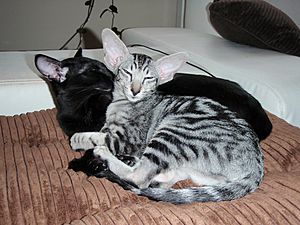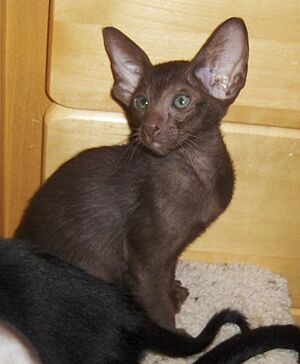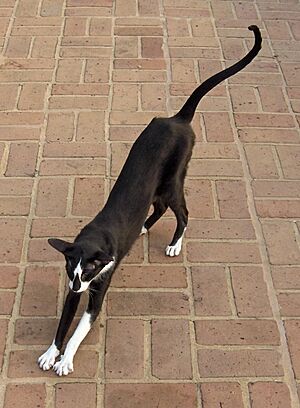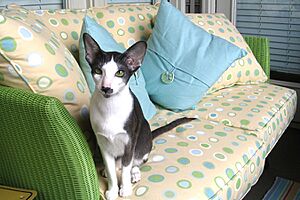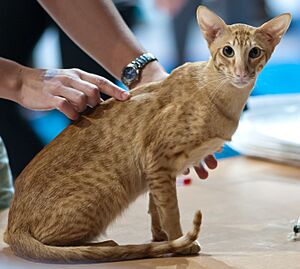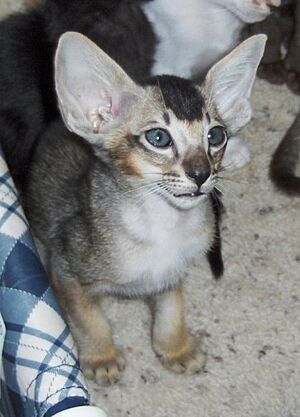Oriental Shorthair facts for kids
The Oriental Shorthair is a type of domestic cat that looks a lot like the Siamese cat. It has the same modern Siamese body and head shape, but it comes in many different colors and patterns. Like the Siamese, Oriental Shorthairs have almond-shaped eyes, a triangular head, large ears, and a long, slender, and muscular body.
These cats are known for being very social and smart. Many of them are quite vocal, meaning they like to "talk" a lot! They often stay playful even when they're grown up, and some even enjoy playing fetch. Even though they look thin, they are very athletic and can jump to high places. They usually prefer living with other cats or people. Unlike the Siamese, which has blue eyes, Oriental Shorthairs usually have green eyes. There's also an Oriental Longhair, which is the same cat but with longer fur.
The Oriental Shorthair's ancestors came from Thailand. However, the breed was officially developed in the United States by cat breeders in the New York area. Key breeders like Vicky and Peter Markstein helped create the breed in the early 1970s. In 1977, the Oriental Shorthair was accepted by the Cat Fanciers' Association (CFA) for championship shows. Later, in 1997, it was also recognized by the GCCF in the UK and other cat organizations.
Quick facts for kids Oriental Shorthair |
|
|---|---|
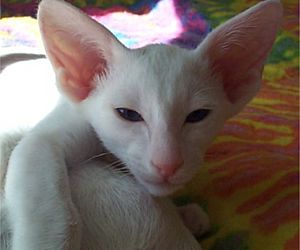
A blue-eyed white Oriental Shorthair kitten. The line of the nose, eyes, and middle of the ear form a triangular wedge.
|
|
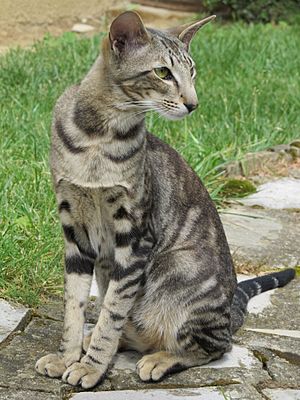
Green-eyed blotched tabby Oriental adult
|
|
| Other names | Foreign Type |
| Origin | United States (landrace stock from Thailand) |
| Breed standards | |
| CFA | standard |
| FIFe | standard |
| TICA | standard |
| WCF | standard |
| AACE | standard |
| ACF | standard |
| ACFA/CAA | standard |
| CCA-AFC | standard |
| GCCF | standard |
| Domestic cat (Felis catus) | |
Contents
What Makes Oriental Shorthairs Special?
Appearance and Body Type
Oriental Shorthairs are part of the Siamese cat family. They have almond-shaped eyes and a wedge-shaped head with big ears. Their bodies are usually sleek but also muscular. They come in many different solid colors and patterns. These include smoke, shaded, parti-color (like tortoiseshell), tabby, and bicolor (any color with white patches). Not all cat organizations accept every color and pattern.
The Oriental Longhair is almost identical, but it has a longer coat. This is because it carries a special gene for long hair.
Personality and Behavior
Oriental Shorthair cats are very active. Adult Oriental Shorthairs are known for being curious and interested in everything around them. They love to explore and play.
Size of Oriental Shorthairs
The Oriental Shorthair is a medium-sized cat. Male cats usually weigh between 8 and 12 pounds. Female cats typically weigh less than 8 pounds.
Health Concerns
Because Oriental Shorthairs are closely related to Siamese cats, they can have similar health issues. Some of these include:
- Amyloidosis (a protein buildup in organs)
- Asthma or bronchial problems
- Heart defects that are present from birth
- Crossed eyes
- Stomach and bowel conditions
- Hyperesthesia syndrome (a skin sensitivity)
- Lymphoma (a type of cancer)
- Nystagmus (uncontrolled eye movements)
- Progressive retinal atrophy (an eye condition)
Oriental Shorthairs also have a lower chance of becoming overweight after they are spayed or neutered.
History of the Breed
The Oriental Shorthair breed started from the Siamese cat. Siamese cats, both pointed and solid-colored, were brought to the UK from Siam (now Thailand) in the late 1800s. From there, they became very popular.
The gene that gives Siamese cats their "pointed" color (darker ears, face, paws, and tail) is a recessive gene. This means that many cats from Siam were actually solid-colored. When these cats were bred, the pointed ones became known as Siamese. The solid-colored ones were sometimes called "non-blue eyed Siamese" or "foreign shorthair." Other breeds that came from the cats of Thailand include the Havana Brown and the Korat.
The Oriental Shorthair was officially recognized as a breed for championship competitions by the Cat Fanciers' Association (CFA) in the US in 1977. In 1985, the CFA also recognized the bicolor (two-color) version of the breed. In the UK, the Governing Council of the Cat Fancy (GCCF) recognized the breed in 1997.
Coat Colors and Patterns
There are over 300 possible coat color and pattern combinations for Oriental Shorthairs! Here are some of the main types:
- Solid: The cat's fur is one uniform color all over. Each hair should be the same color from root to tip. Colors can include red, cream, ebony (black), blue, lavender, cinnamon, fawn, and white.
- Shaded: These cats have a white undercoat, and only the tips of their fur are colored. Some registries call this the chinchilla pattern.
- Smoke: The hair shaft has a thin band of white at the base, which you can only see if you part the fur. This gives the cat a smoky appearance.
- Parti-color: These cats have patches of red and/or cream. These patches can be clear blotches or look marbled. This pattern is often called tortoiseshell (or "tortie").
- Tabby coat pattern: Tabby cats have stripes, spots, or swirls. There are four main types of tabby patterns: classic, mackerel, spotted, and ticked.
- Bicolor pattern: A bicolor cat has white patches along with another color or pattern. They often have white on their belly, legs, paws, and an inverted "V" shape on their face.
Images for kids
See also
 In Spanish: Gato oriental para niños
In Spanish: Gato oriental para niños


